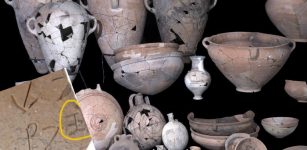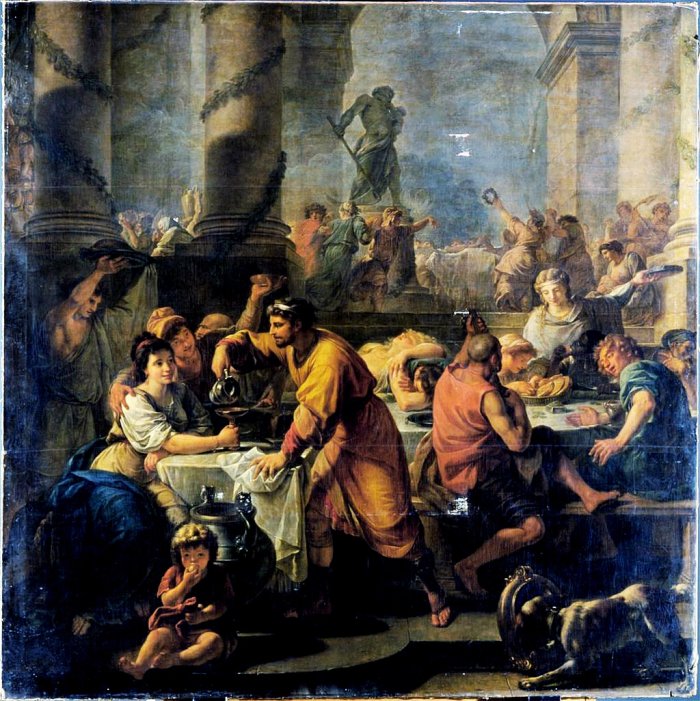Saturnalia Feasts In Roman Empire
A. Sutherland - AncientPages.com - The Romans had many days of religious significance and some of these lasted only a few hours, while others – such as the festival of Saturnalia – could last for almost an entire week and later even more.
Saturnalia by Antoine Callet. Image credit: Themadchopper, Antoine-François Callet - source - CC0 1.0
The Roman calendar included a large number of public holidays, called feriae that increased in number as time went on.
One popular Roman holiday was the Saturnalia held during the winter solstice.
Saturnalia feasts were established in honor of the god Saturn who was a god of agriculture. The holiday included the day of Saturn – the god of seeds and sowing – which was the Saturnalia itself. The holiday began as a farmers’ festival to mark the end of autumn planting and at first, it was held just after the last wheat crop of the year was sown.
Eventually, the Romans settled on December 17 as the date to celebrate the Saturnalia.
Later, the 17th was given over to the Opalia, a feast day dedicated to Saturn’s wife and the goddess of abundance and the fruits of the earth.
Associated with heaven (Saturn) and Earth (Opalia), the Saturnalia ended up combined, according to Macrobius, a Roman Latin grammarian and philosopher, who flourished in AD 400 and whose most important work is the “Saturnalia”, a compendium of ancient Roman religious and antiquarian lore.
The third one, was a feast day celebrating the shortest day, called the bruma by the Romans. The Brumalia coincided with the solstice, on 21 or 22 December.
Ave, Caesar! Io, Saturnalia! Sir Lawrence Alma-Tadema - 1880 Akron Art Museum (United States) Painting - oil on panel. Image credit: Lawrence Alma-Tadema - source - Public Domain
Thus, the holiday became a seven-day-long festival for the Roman people. Later, the emperor Augustus who ruled from 27 BC-AD 14, shortened the Saturnalia to a three-day holiday, as it was causing chaos in the people’s working days.
It worked for some time but Caligula who ruled AD 37–41, extended it again to a five-day holiday. By the time of Macrobius, the Saturnalia was an almost two-week holiday.
The first Saturnalia was in 497BC when the Temple of Saturn in Rome was dedicated. As with so many Roman traditions, the origins of the Saturnalia are lost to the mists of time.
Some of the Saturnalia days included private rituals of worship, but more common were religious rites performed by state officials at mass ceremonies, accompanied by public entertainments held as a part of the religious observances.
The official component of the Saturnalia was on December 17, when the senators performed a mass animal sacrifice at the temple of Saturn, and afterward, there was a huge banquet to which everyone was invited. The rest of the week, the people participated in nonstop parties and feasts. All shops, schools, and other important institutions were closed.
In "Daily Life In The Roman City", Gregory S. Aldrete writes that "normal moral restraints were loosened and everyone was expected to engage in all forms of revelry and fun. This was the only time of year when people were legally allowed to gamble in public. Bands of revelers ran through the streets drinking and shouting "lo Saturnalia..."
Written by - A. Sutherland - AncientPAges.com Senior Staff Writer
Copyright © AncientPages.com All rights reserved. This material may not be published, broadcast, rewritten or redistributed in whole or part without the express written permission of AncientPages.com
Expand for referencesMore From Ancient Pages
-
 Confucius: Philosopher, Educationist And Great Intellect With A Noble Morality
Featured Stories | Jul 27, 2016
Confucius: Philosopher, Educationist And Great Intellect With A Noble Morality
Featured Stories | Jul 27, 2016 -
 More Than A Meteorite: New Clues About The Demise Of Dinosaurs
Paleontology | Dec 5, 2023
More Than A Meteorite: New Clues About The Demise Of Dinosaurs
Paleontology | Dec 5, 2023 -
 One Of Egypt’s Oldest Christian Churches Discovered By Polish Archaeologists
Archaeology | May 31, 2019
One Of Egypt’s Oldest Christian Churches Discovered By Polish Archaeologists
Archaeology | May 31, 2019 -
 Death Of Norse God Balder And Loki’s Mischief That Led To Destruction In Ragnarok
Featured Stories | Nov 15, 2016
Death Of Norse God Balder And Loki’s Mischief That Led To Destruction In Ragnarok
Featured Stories | Nov 15, 2016 -
 Baku’s Mysterious Maiden Tower – Legend Of The Daughter Of Fire Who Saved The Sacred Temple May Be True
Featured Stories | Jul 5, 2021
Baku’s Mysterious Maiden Tower – Legend Of The Daughter Of Fire Who Saved The Sacred Temple May Be True
Featured Stories | Jul 5, 2021 -
 120,000-Year-Old Bone Etchings – Evidence Of The Earliest-Known Use Of Symbols
Archaeology | Feb 3, 2021
120,000-Year-Old Bone Etchings – Evidence Of The Earliest-Known Use Of Symbols
Archaeology | Feb 3, 2021 -
 Canaanite Temple Dated To 12th Century BC Unearthed At Lachish, Israel
Archaeology | Feb 19, 2020
Canaanite Temple Dated To 12th Century BC Unearthed At Lachish, Israel
Archaeology | Feb 19, 2020 -
 Emperor Kublai Khan: One Of The Most Powerful People In Human History
Featured Stories | May 23, 2017
Emperor Kublai Khan: One Of The Most Powerful People In Human History
Featured Stories | May 23, 2017 -
 First Odometer Was Invented By Vitruvius Around 15 BC
Ancient History Facts | Jan 24, 2016
First Odometer Was Invented By Vitruvius Around 15 BC
Ancient History Facts | Jan 24, 2016 -
 Unusual Find – Headless Skeletons Discovered In A 7000-Year-Old Mass Grave In Slovakia
Archaeology | Jan 12, 2023
Unusual Find – Headless Skeletons Discovered In A 7000-Year-Old Mass Grave In Slovakia
Archaeology | Jan 12, 2023 -
 The Sumerian King Who Received A Divine Tablet With Secrets Of The Gods And Changed History Of Mesopotamia
Featured Stories | May 30, 2021
The Sumerian King Who Received A Divine Tablet With Secrets Of The Gods And Changed History Of Mesopotamia
Featured Stories | May 30, 2021 -
 Bizarre Devil’s Tramping Ground In North Carolina Is Avoided By People And Animals
Featured Stories | May 1, 2019
Bizarre Devil’s Tramping Ground In North Carolina Is Avoided By People And Animals
Featured Stories | May 1, 2019 -
 Enigmatic Green Lady In British Folklore
Featured Stories | Jan 9, 2017
Enigmatic Green Lady In British Folklore
Featured Stories | Jan 9, 2017 -
 Strange Ancient Labyrinth City Under The Sands Of The Kara Kum Desert Reveals Its Secrets
Civilizations | Sep 29, 2014
Strange Ancient Labyrinth City Under The Sands Of The Kara Kum Desert Reveals Its Secrets
Civilizations | Sep 29, 2014 -
 12,000-Year-Old Ice Age Stone Tools Found – Earliest Dated Evidence For Human Activity in Scotland
Archaeology | Oct 10, 2015
12,000-Year-Old Ice Age Stone Tools Found – Earliest Dated Evidence For Human Activity in Scotland
Archaeology | Oct 10, 2015 -
 Cahuachi – Complex Of Truncated Adobe Pyramids In Peru’s Desert
Civilizations | Aug 27, 2015
Cahuachi – Complex Of Truncated Adobe Pyramids In Peru’s Desert
Civilizations | Aug 27, 2015 -
 Ancient Campfires Reveal A 50,000-Year-Old Grocer And Pharmacy In Australia
Archaeology | Apr 14, 2022
Ancient Campfires Reveal A 50,000-Year-Old Grocer And Pharmacy In Australia
Archaeology | Apr 14, 2022 -
 Library Of Celsus: Beautiful Classic Monument In Ephesus That Stored 12,000 Scrolls
Civilizations | Nov 14, 2018
Library Of Celsus: Beautiful Classic Monument In Ephesus That Stored 12,000 Scrolls
Civilizations | Nov 14, 2018 -
 On This Day In History: Sir Thomas Brisbane, Astronomer, Soldier And Governor Was Born – On July 23, 1773
News | Jul 23, 2016
On This Day In History: Sir Thomas Brisbane, Astronomer, Soldier And Governor Was Born – On July 23, 1773
News | Jul 23, 2016 -
 Yuki-Onna ‘Lady Of The Snow’: A Female Demon And Symbol Of Death In Japanese Mythology
Featured Stories | Mar 7, 2019
Yuki-Onna ‘Lady Of The Snow’: A Female Demon And Symbol Of Death In Japanese Mythology
Featured Stories | Mar 7, 2019


